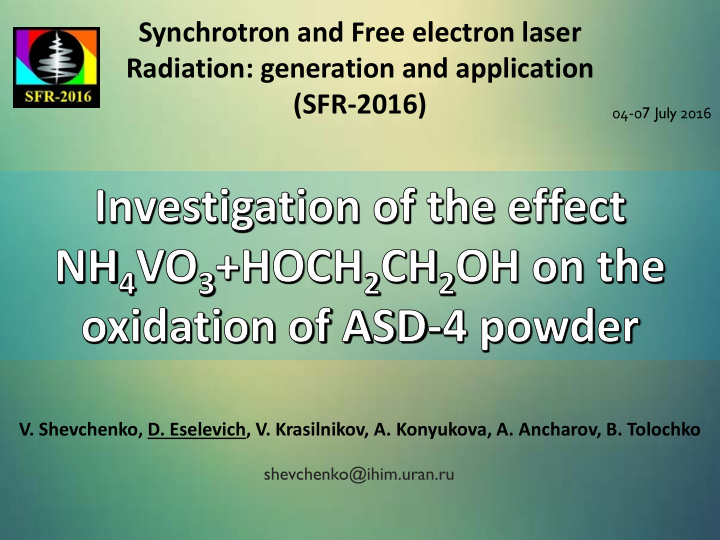



Synchrotron and Free electron laser Radiation: generation and application (SFR-2016) 04-0 7 July 2016 V. Shevchenko, D. Eselevich, V. Krasilnikov, A. Konyukova, A. Ancharov, B. Tolochko shevchenko@ihim.uran.ru
The aluminum powders belong to a class of functional materials of high industrial importance. Having a unique set of chemical and physico-chemical properties, as well as a high level of energy intensity, aluminum powders are widely used: in explosives; • in the production of high-energy fuel mixtures; • In solid fuel rocket engines, whose combustion parameters optimization is a very • important and actual problem. However, the high barrier properties of the metal oxide film on the surface of the particles of the metal do not allow its potential to be realized completely. 2
• Protection and activation of dispersed aluminum with organic modifiers; • Activation by doping of aluminum with active metals; • Encapsulation of aluminum powder particles with d-metals allowing one to reduce agglomeration and to displace the initial stage of oxidation into the low temperature region; • Introduction of WO 3 , MoO 3 , V 2 O 5 , Ta 2 O 5 , Fe 2 O 3 , Bi 2 O 3 , CuO oxide additives, which are strong oxidizing agents directing the reaction to the surface by the thermite type; • Introduction of low melting alkali metal polyvanadate additives considered as efficient oxygen transporters through the barrier layer and as aluminum oxide oxidation catalysts; The method proposed early by our laboratories for surface modification of Al micro-powders, based on their impregnation with vanadium hydrogels, in particular V 2 O 5 ∙ nH 2 O, turned to be highly efficient. Surface modification provides reduction of the metal powder ignition delay and activates the combustion process due to the formation of reactive and catalytically active components. 3
ASD-4 V 2 O 5 ∙ nH 2 O The completeness of oxidation: ∆α V2O5 = 90% ∆α asd-4 = 44% 1. V 2 O 5 + Al 2 O 3 → 2 AlVO 4 The mechanism of oxidation of the modified 2. 10Al + 3V 2 O 5 → 5Al 2 O 3 + 6V powder: 3. 3Al + V → Al 3 V; 8Al + 5V → Al 8 V 5 4
The high reactivity of alumina nanopowders makes them unsuitable for • modification with vanadium hydrogels, as they may react with water contained in them reducing thereby the concentration of the active metal. The alternative method based on the impregnation of alumina powder • with vanadium-containing solutions produced by dissolution of ammonium metavanadate in ethylene glycol during weak heating. ASD-4 + NH 4 VO 3 ・ HOCH 2 CH 2 OH The use of a non-aqueous solvent lowers the probability of its interaction with metal and enables the activation of aluminum powders with a wide range of dispersity. 5
NH 4 VO 3 ・ HOCH 2 CH 2 OH heated at 323 K for 60 hours • Aluminum powder was added to the prepared solution • The resulting mass was mixed • Heated in a vacuum oven at 473 K to remove the solvent 6
ASD-4 NH 4 VO 3 +HOCH 2 CH 2 OH The completeness of oxidation ∆α asd-4 ・ NH4VO3 = 60% ASD-4 ∆α asd-4 = 44% The ethylene glycol modified ASD-4 metavanadate powder begins NH 4 VO 3 +HOCH 2 CH 2 OH to react noticeably with oxygen at about 773 K, i.e. ASD-4 below the melting points of Al (933 K) 7
Al Al 303 К 773 К 473 К Al Al 2 O 3 Al 2 O 3 Al 2 O 3 VO 2 V 6 O 13 V 2 O 5 γ -Al 2 O 3 ⍺ -Al 2 O 3 ⍺ -Al 2 O 3 1143 К 1373 К 943 К AlVO 4 Al 3 V Al 3 V Al 8 V 5 Al 8 V 5 The variety of processes taking place almost simultaneously in the volume and on the surface of the sample, which is due to vanadium polyvalence, as well as the low temperature destruction of the oxide shell promote efficient transport of oxidant (oxygen) to the metal surface. 8
ASD-4 V 2 O 5 ∙nH 2 O ASD-4 The latter modifier is inferior in NH 4 VO 3 +HOCH 2 CH 2 OH • the final degree of oxidation, but for the more active powders the use of ethylene glycol The reduction of the degree of conversion can be due to the decomposition of a • more complex modifier based on ethylene glycol and ammonium metavanadate because in this case expenditure of energy is required. Active pentoxide appears on the diffraction patterns only above 673 K. 9
• The oxidation of ASD-4 powder, the surface of which is modified with NH 4 VO 3 + HOCH 2 CH 2 OH, has been studied for the first time during programmed heating in air up to 1473 K at a rate of 10 K / min. • It was established experimentally that the surface impregnation of Al powder leads to significant activation of the oxidation process above the melting point of Al and shifts the process to lower temperatures. • Using the X-ray diffraction method with a synchrotron radiation source, we have obtained the information about the phase formation processes during occurring heating in air in the conditions similar to thermoanalytical studies. 10
Recommend
More recommend